The Cardiology and Cardiovascular Surgery faculty of Columbia University Vagelos College of Physicians and Surgeons and Weill Cornell Medicine continue to advance treatment for heart disease through clinical and scientific programs that are among the most innovative and comprehensive in the country.
NewYork-Presbyterian Hospital’s adult cardiology and heart surgery programs – ranked #4 in the country by U.S.News & World Report – make it a destination for patients from around the world.
A Novel Shunt Approach for End-Stage Pulmonary Arterial Hypertension
Applying Machine Learning to Accelerate Right Heart Imaging
Advancing Cardiac Imaging in the Structural Disease Space
Cardiac Sarcoma: Two Surgical Specialties Are Better Than One
Reversing Left Ventricular Remodeling
Valve-Sparing Root Replacement: Getting to the Cusp of the Matter
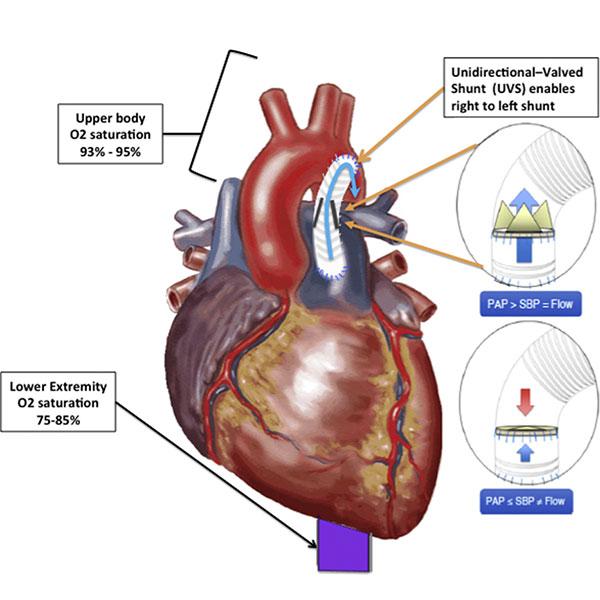
A Novel Shunt Approach for End-Stage Pulmonary Arterial Hypertension
A novel unidirectional-valved shunt approach that provides an enduring bridge to lung transplant is providing hope for adolescents and young adults with end-stage pulmonary arterial hypertension who have failed medical therapies. Columbia cardiologists and cardiac surgeons at NewYork-Presbyterian Hospital have designed a novel unidirectional-valved shunt as a pressure release valve to permit flow from the main pulmonary artery to the descending aorta only during periods of suprasystemic pulmonary arterial pressure. Unlike the classic reversed Potts shunt, the one-way valve allows the blood to flow only from the pulmonary artery to the descending aorta without “back flow” when the heart relaxes, avoiding any additional trauma to lung circulation.
Unidirectional valve shunt design shows the site of surgical insertion of the valved conduit from the superior aspect of the main pulmonary artery to the descending aorta distal to left subclavian artery.

Applying Machine Learning to Accelerate Right Heart Imaging
In some cardiac conditions, the right heart is just as important a structure, if not more important, than the left heart. If the right heart is failing, the risk of mortality increases substantially even if the left heart function is normal. Weill Cornell cardiac imaging specialists have developed machine learning techniques to segment the right ventricle in which they can process thousands of echoes quickly. The researchers conducted a multimodality validation study of a novel machine learning model for right ventricular quantification on echocardiography, one of the first studies using machine learning applications for the right ventricle. Many images can be analyzed in seconds, avoiding pitfalls associated with conventional techniques for right ventricular evaluation.
An initial validation of a deep learning system for right ventricle assessment using automated tracking of the tricuspid annulus; figure demonstrates representative lateral and septal annular displacement performed both manually and by machine learning algorithm.
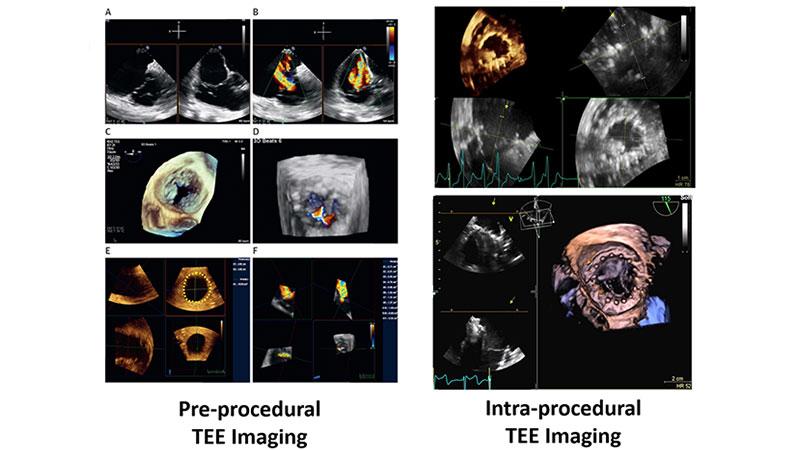
Advancing Cardiac Imaging in the Structural Disease Space
The cardiac faculty at Columbia are conducting new clinical trials for nonsurgical treatment of mitral and tricuspid valve disease, the success of which relies on the ability to perform high quality imaging studies. A study led by Columbia interventional echocardiographers and cardiologists evaluated 3D transesophageal echocardiographic (TEE) imaging, which is frequently used as an initial screening tool in the evaluation of patients who are candidates for transcatheter tricuspid valve replacement. They found that 3D TEE measurements of tricuspid annular dimensions display strong correlations with CT measurements in patients undergoing screening and therefore should be proposed as a reasonable alternative to CT imaging in this vulnerable population.
Pre-procedural and Intra-procedural imaging for transcatheter tricuspid valve interventions
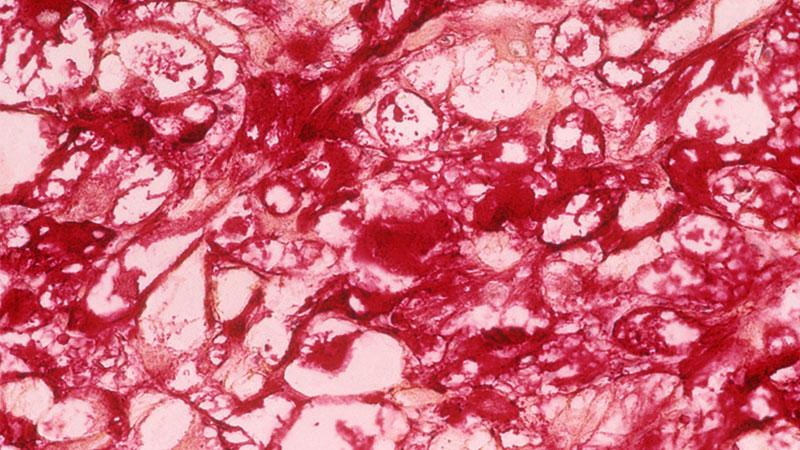
Cardiac Sarcoma: Two Surgical Specialties Are Better Than One
This potentially lethal and rare type of primary malignant tumor generally originates in the muscle or blood vessels of the heart and was previously considered unresectable. Survival depends on the extent of cardiac structures involved and if surgical resection – considered the definitive treatment for cardiac sarcomas – is even possible. At Weill Cornell, cardiac and thoracic surgeons take a collaborative approach to address tumors that cross into or emanate from the heart, consistently demonstrating in a 20-year retrospective review that by combining their expertise in the OR they can successfully remove tumors. The surgeons note that neoadjuvant therapy is now known to increase the rate of complete resection and therefore improve survival.
Light micrograph of a section through a heart affected by rhabdomyosarcoma
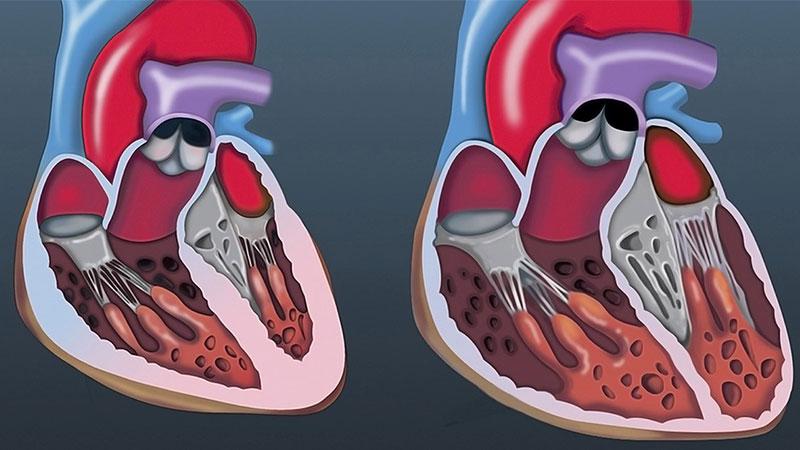
Reversing Left Ventricular Remodeling
In chronic heart failure with reduced ejection fraction, left ventricular remodeling can result in ventricular dilation, transition of the chamber shape, and the shifting of papillary muscles and mitral valve apparatus into abnormal positions. Heart failure specialists at Columbia conducted a comprehensive review of treatment options that focus on restoring the normal ventricular size and preventing the remodeling process from continuing, providing insight into the impact of remodeling on ventricular dysfunction. The authors focus on two fundamental therapeutic approaches – those that rely primarily on biological mechanisms to improve myocardial function and physical mechanisms involving procedures to reduce myocardial wall stress through ventricular constraint or reshaping.
Medical illustration comparing normal heart (left) with heart with dilated cardiomyopathy
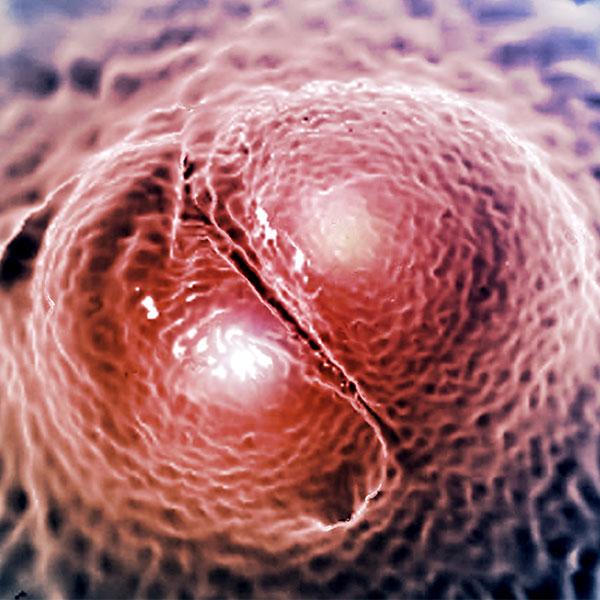
Valve-Sparing Root Replacement: Getting to the Cusp of the Matter
While valve-sparing root replacement using reimplantation techniques is increasingly applied to bicuspid aortopathy, long-term durability of cusp repair remains uncertain. Cardiac surgery faculty at Weill Cornell advanced understanding of this issue with a study reviewing midterm results of a conservative approach to cusp repair in 66 patients with bicuspid valves. The majority of the patients (51) did not require cusp repair, few patients progressed in degree of aortic insufficiency, and the need for reoperation was rare at midterm follow-up. The authors conclude that the procedure is reliably performed with bicuspid aortic valves regardless if cusp reconstruction is necessary, and that many of these valves can be repaired that would have previously been replaced.
3D CT of bicuspid aortic valve congenital deformity in 58-year-old man



